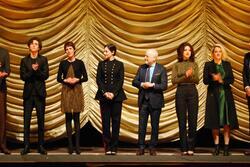The Future of Jewish Queer Cinema
I have seen queer films before. I’ve seen Jewish films before. But for some reason, seeing the two collide on-screen sometimes makes me squirm. Usually it’s because one of these identities is the main focus of the movie, and the other is a half-baked idea lazily inserted into the plot. I either end up watching a movie about a queer story with a main character who happens to be Jewish, or a Jewish story with a main character who happens to be queer. Still, some movies were able to bridge this gap; the most recent successful interpretation I had the pleasure of viewing was Tahara. Similar to Rachel Sennott’s other film in which she held a leading role, Shiva Baby, Tahara tells a tale of reconciliation of queer and Jewish identities.
Queer Jewish movies aren’t necessarily new, but they are hard to come by. While queer lives on film can be traced back to the beginnings of film itself (though most early portrayals were done through the lens of German Expressionism), more mainstream films didn’t crop up until the 70s and 80s. As we started to edge toward the beginning of New Queer Cinema, we got movies like The Boys in the Band and Torch Song Trilogy. Both of these movies center around the lives of gay Jewish men and both raise awareness about commonly misused tropes in regards to homosexual relationships on screen. For instance, one of the main characters in The Boys in the Band criticizes the old “Bury Your Gays” trope, stating, “Show me a happy homosexual and I'll show you a gay corpse.” Torch Song Trilogy, especially, uses dry and traditionally Jewish humor to breathe life into old stereotypes about drag queens and humanize queer lives on screen in a way many earlier films were tentative to even attempt in the wake of a post-Hays Code America.
Ironically, the 1990s and early 2000s were filled with juxtaposing views of homosexuality. The aforementioned New Queer Cinema movement was in full swing, and radical filmmakers like Todd Haynes, Greg Araki (a personal favorite), and John Waters were some of the pioneers of America’s raunchiest, yet most authentic, showcasings of queer lives to date. Whereas The Boys in the Band and Torch Song Trilogy mostly centered around cisgender white men, films and documentaries alike, such as Paris Is Burning, The Watermelon Woman, Poison, and The Living End brought more diverse voices into the conversation. Most of these movies weren’t blockbuster films, however. Mainstream media often lagged behind the radicality of the New Queer Cinema Movement. A few popular box office films tried their hand at gay representation, most notably Philadelphia, In & Out, and The Birdcage (which is also Jewish!). Many of these movies were light-hearted romantic comedies (though not Philadelphia!), a needed refresher for many queer people as the AIDS epidemic raged on. Movies like these made queerness more accessible to an audience that has been spoon-fed a narrative of obscenity when the disease first began to be politicized. People started to see the LGBTQ+ community as people, not as victims, thanks to the efforts of these silly and lighthearted movies.
During this time, and moving towards the beginning of the 21st century, some Jewish interpretations of queerness began to take shape in the film industry. Kissing Jessica Stein was released in 2001 to great acclaim. Critics loved it for its witty tongue-in-cheek humor, audiences loved it for its “Sex and the City” feel, and the queer community loved it because, well, it was queer. Kissing Jessica Stein was a step in the right direction for movies addressing homosexuality within a Jewish context. However, not all films that portrayed the intersections of these identities did so with as much taste or forethought.
In an effort to boil Judaism down to a single, easily-digestible perspective, some movies used stereotypical portrayals of Jews to highlight the apparent mutual exclusivity between Jewish American culture and a queer lifestyle. While there certainly are Jewish communities where queerness is frowned upon, the problem with mainstream films like these lies in the prolific rate they are a) being produced, and b) being consumed by non-Jewish audiences.
Most of these movies alienate audiences from Jewish culture altogether: it’s hard to find emotional resonance with a force that seems to be in direct opposition to the protagonist, who is, in most cases, the “exiled Jew.” True to Newtonian Law, if these movies are to exist and be regularly consumed by non-Jews, there must be an equal and opposite movement to include stories that shed a positive light on queer Jews. Though both kinds of films have always existed at the same time, and neither is worse than the other for their depiction of these intersections, it is still important to consider the role of each in perpetuating outdated stereotypes.
Like all kinds of media that seek to portray underrepresented perspectives, there is good representation and bad representation. The New Queer Cinema movement changed how we see LGBTQ+ representation, and what it means to make movies for queer people, as opposed to those about queer people. Movies like The Boys in the Band and Torch Song Trilogy were offspring of this movement that add another element into the mix: Jewishness. This confluence has evolved over time as new voices have gained momentum: Jews of color, trans Jews, disabled Jews and many other marginalized groups have all recently found space in the film industry. Movies made in the past decade like Tahara, Shiva Baby, and Fig Tree reflect these efforts. Tahara, specifically, recounts the messy and tumultuous nature of Jewish adolescence and the nuance behind the meaning of “purification” (hence the name of the movie). Revolutionary movies such as this could not be made without the trials and tribulations of past films working to represent queer Jewish lives.
Progress is not linear, and this remains true when examining the relationship between Jewishness and queerness in film. Though the relationship between the two is winding and labyrinthine, good representation has remained relevant and continues to fuel future progress. Past and present writers, filmmakers, and actors alike have all worked to carve out space for movies that center around authenticity and humanity for queer and Jewish characters. As consumers, our job is to hold them accountable and invest in a future for films that have a positive impact on Jewish and LGBTQ+ communities.
This piece was written as part of JWA’s Rising Voices Fellowship.







